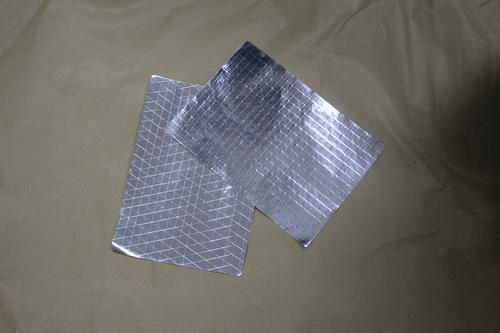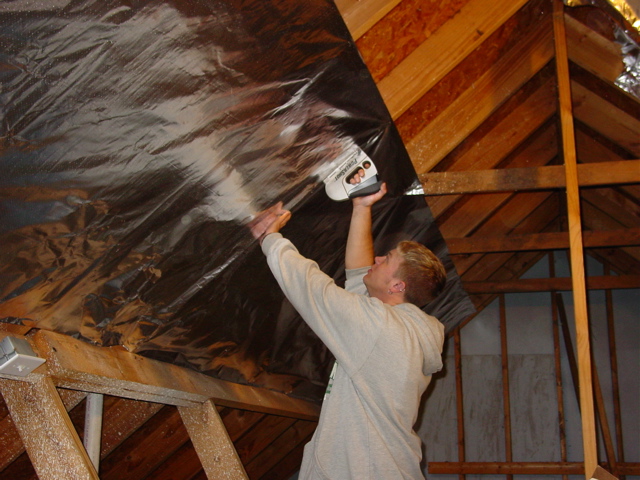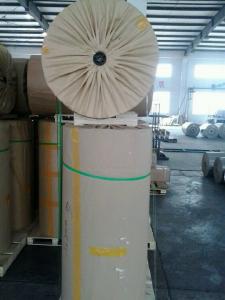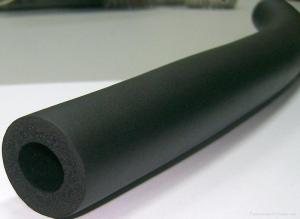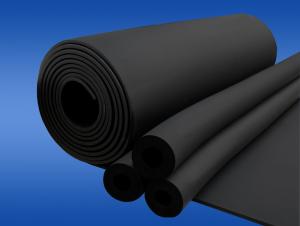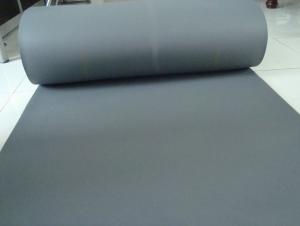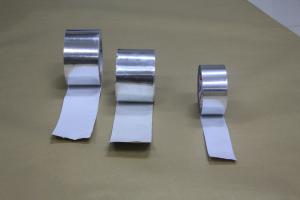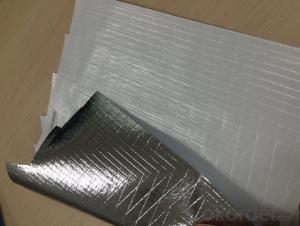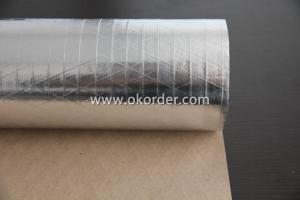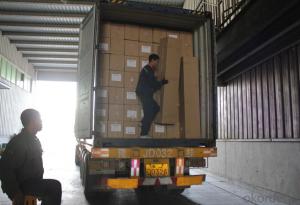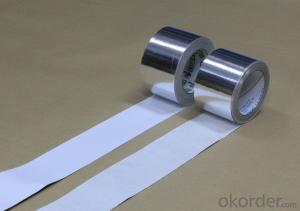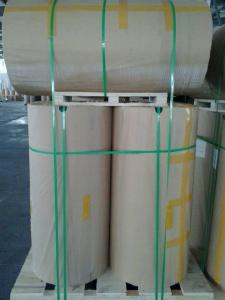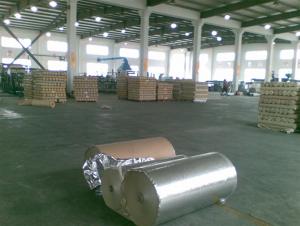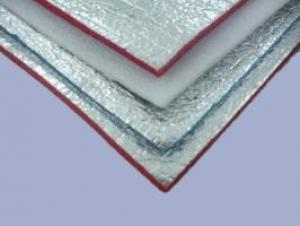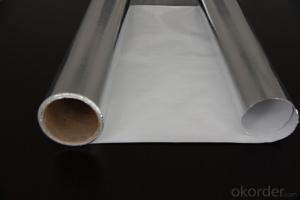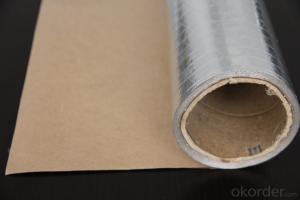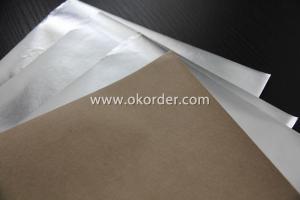FSK7160B Aluminum Foil Facing Insulation Board
- Loading Port:
- China Main Port
- Payment Terms:
- TT OR LC
- Min Order Qty:
- -
- Supply Capability:
- -
OKorder Service Pledge
Quality Product, Order Online Tracking, Timely Delivery
OKorder Financial Service
Credit Rating, Credit Services, Credit Purchasing
You Might Also Like
Material Structure: AL/2 way scrim/Paper | ||
Paper Weight:60gsm ( Standard, can be Customized) | ||
Roll Size:1.2m*50m ,1.25*50m (can be customized) | ||
PROPERTIES | TEST DATA | UNIT |
Thickness | +-0.15 | mm |
Weight | +-110 | gsm |
Emissivity | 0.03-0.04 | COEF |
Thermal conductivity | 0.037 | w/m0 |
Bursting Strength | 90 | N/25mm |
Reflectivity | 96-97 | % |
Water Vapour Transmission | 1.15 | Ng/N.S |
Corrosion | doesn't generate | |
Tensile Strength(MD) | 144.4 | N/25mm |
Tensile Strength(TD) | 46.3 | N/25mm |
- Q: This question asks for a method to determine the thickness of an aluminum foil sheet.
- <p>To measure the thickness of an aluminum foil sheet, you can use a digital caliper or a micrometer. Place the foil between the jaws of the caliper and take the measurement. If you don't have these tools, you can use the 'multiple fold' method: fold the foil in half repeatedly and measure the total thickness after several folds, then divide by the number of layers to estimate the single layer thickness. For a more precise measurement, especially for thinner foils, consider using a thickness gauge designed for measuring thin materials.</p>
- Q: Can aluminum foil facing be used to create a thicker pizza crust compared to standard crusts?
- <p>Yes, you can use aluminum foil facing to make a thicker pizza crust. The foil provides a solid surface to prevent the dough from spreading too thin. To achieve a thicker crust, roll out your dough to your desired thickness and place it on the foil. Make sure the edges are thicker than the center for a traditional pizza crust look. Pre-bake the crust if necessary to set its shape before adding toppings.</p>
- Q: Is it possible to reuse the aluminum foil that was previously used on a surface?
- <p>Reusing aluminum foil facing can be tricky. If the foil is still in good condition without any tears or punctures, and it's clean, you might be able to reuse it for a similar application. However, it's important to note that the adhesive on the back of the foil can weaken over time and with use, which may affect its ability to stick properly. Additionally, if the foil has been exposed to high heat or has been used in a way that compromises its integrity, it's safer and more effective to replace it with new foil to ensure the best performance and avoid any potential hazards.</p>
- Q: This question asks for the optimal methods of preserving leftover food using aluminum foil.
- <p>The best ways to store leftovers using aluminum foil involve ensuring the food is cool before wrapping, covering the entire dish tightly, and sealing the foil properly. First, let the leftovers cool down to room temperature to prevent condensation. Then, wrap the dish completely with aluminum foil, making sure to cover the edges and corners to avoid air exposure. For added protection, you can double-wrap the dish. Seal the foil by pressing the edges together firmly. Store the wrapped leftovers in the refrigerator or freezer, depending on how soon you plan to consume them.</p>
- Q: This question asks about the various types of aluminum foil facing used in construction and insulation materials.
- <p>Aluminum foil facing is used in various applications, including insulation and construction materials. The different types include: 1) Plain Foil Facing, which is a smooth, uncoated aluminum foil; 2) Coated Foil Facing, which has a protective coating applied to one or both sides; 3) Laminated Foil Facing, where aluminum foil is bonded to other materials like polyester or polyethylene; 4) Embossed Foil Facing, featuring a pattern or texture on the surface for added strength or aesthetic purposes; and 5) Reinforced Foil Facing, which incorporates additional materials to enhance durability and tear resistance.</p>
- Q: What are the considerations or safety measures to be aware of when using aluminum foil with a nonstick coating?
- <p>When using aluminum foil with a nonstick coating, it's important to avoid exposing it to high heat as the nonstick layer can degrade and release harmful fumes. Do not use it in broilers, on grills, or in the oven at temperatures exceeding 400掳F (204掳C). Additionally, refrain from cutting or puncturing the foil, as this can damage the nonstick surface. Avoid using metal utensils that might scratch the coating. Always follow the manufacturer's guidelines for safe use and temperature limits.</p>
- Q: This question asks about the various types of aluminum foil facing that can be found in the market.
- <p>Aluminum foil facing is commonly used in construction for insulation and moisture protection. The different types available on the market include: 1) Plain Foil Facing, which is a simple, smooth aluminum surface; 2) Embossed Foil Facing, featuring a textured pattern for added strength; 3) Reinforced Foil Facing, which incorporates additional materials for enhanced durability; 4) Coated Foil Facing, where the aluminum is coated with other substances to improve performance; and 5) Laminated Foil Facing, which combines aluminum with other materials for specific applications. Each type serves different purposes and has unique properties that cater to various construction and industrial needs.</p>
- Q: The user is asking if it's possible to use aluminum foil with a shiny side facing outward to create a sandwich roll.
- <p>Yes, you can use aluminum foil to make a sandwich roll, but it's not recommended to use the shiny side facing outward. The dull side of the foil is typically used for food contact because it's less likely to transfer any potential residues or chemicals to the food. The shiny side may have a coating that isn't safe for direct food contact. Always ensure that the foil is food-safe and use it according to the manufacturer's instructions.</p>
- Q: How should one properly clean and store aluminum foil facing after usage to maintain its quality and hygiene?
- <p>The best way to clean your aluminum foil facing after use is to gently wipe it with a damp cloth to remove any residue. Avoid using abrasive materials as they can scratch the surface. After cleaning, let it dry completely. To store, roll it up tightly or fold it neatly, and keep it in a cool, dry place away from direct sunlight to prevent any damage or discoloration. Use a resealable plastic bag or a designated container to protect it from dust and moisture.</p>
- Q: The user is asking if aluminum foil can be used to make a pizza crust more flaky and tender.
- <p>Using aluminum foil facing on a pizza crust won't inherently make it more flaky or tender. The flakiness and tenderness of a pizza crust are determined by the ingredients used and the method of preparation. For a flakier crust, consider using a higher fat content like butter or shortening, and for tenderness, ensure proper hydration and kneading of the dough. Aluminum foil is typically used for its heat distribution properties and to prevent direct contact with the oven rack, which can help in browning the bottom of the crust. However, it doesn't affect the flakiness or tenderness directly.</p>
Send your message to us
FSK7160B Aluminum Foil Facing Insulation Board
- Loading Port:
- China Main Port
- Payment Terms:
- TT OR LC
- Min Order Qty:
- -
- Supply Capability:
- -
OKorder Service Pledge
Quality Product, Order Online Tracking, Timely Delivery
OKorder Financial Service
Credit Rating, Credit Services, Credit Purchasing
Similar products
Hot products
Hot Searches
Related keywords


